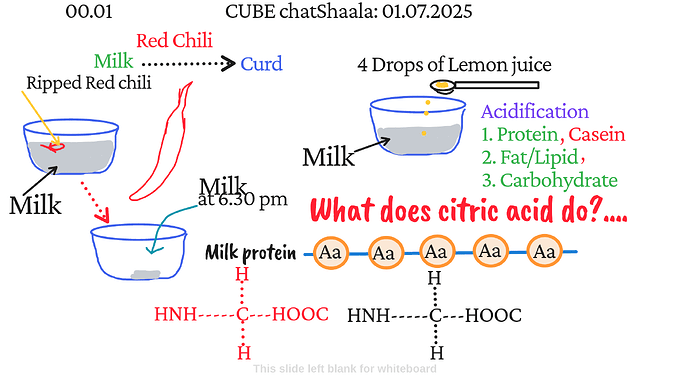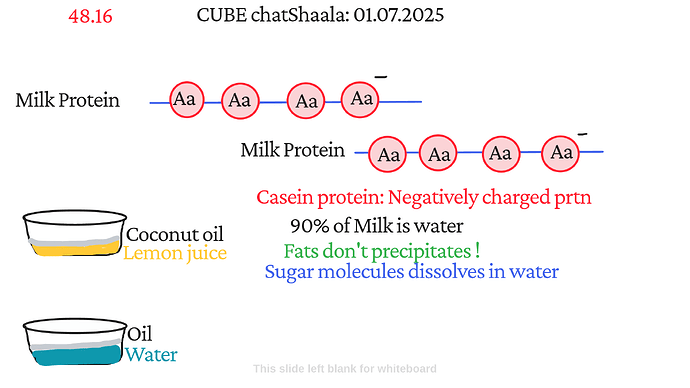Topic : Milk Curdling by Lemon Juice vs Red Chili — What is Real Curd?
The ChatShaala began by observing and comparing two methods of milk curdling:
1. Addition of Lemon Juice
2. Addition of a Ripped Red Chili into Milk
![]() Key Discussions and Observations
Key Discussions and Observations
![]()
What happens when lemon juice is added to milk?
● 4 drops of lemon juice were added to a bowl of milk.
● This caused acidification, primarily due to citric acid in lemon juice.
● Citric acid acts on:
-
Proteins – Especially casein, a milk protein
-
Lipids/Fats – No precipitation observed
-
Carbohydrates – Dissolved in water
![]() Casein and Protein Precipitation
Casein and Protein Precipitation
Casein proteins in milk carry negative charges and remain dissolved in water under normal conditions.
On acidification ( pH drop ), the negative charge is neutralized, causing proteins to clump and precipitate, forming curd.
![]() Molecular Understanding
Molecular Understanding
![]() ︎ Milk protein chains ( polypeptides ) are formed by amino acids of (Aa) with functional groups like –NH₂ and –COOH.
︎ Milk protein chains ( polypeptides ) are formed by amino acids of (Aa) with functional groups like –NH₂ and –COOH.
![]() ︎ Upon acidification, ionic interactions break, causing structural collapse and aggregation of proteins.
︎ Upon acidification, ionic interactions break, causing structural collapse and aggregation of proteins.
![]() What about Red Chili-induced curdling?
What about Red Chili-induced curdling?
A ripped red chili was placed in milk and left for several hours.
Preliminary observation: some thickening/coagulation was noticed.
Suggests possible microbial action or leaching of acidic compounds or enzymes from the chili.
But is it the same as traditional curd? — This remains an open question.
![]() Control Observations with Oil, Water & Lemon Juice
Control Observations with Oil, Water & Lemon Juice
Coconut oil and lemon juice separated into distinct layers, showing that fats don’t precipitate upon acidification.
Water layer remained separate; sugars dissolved, as expected.
This supports the idea that only proteins like casein are responsible for curd formation.
![]() Open-ended Queries for Further Discussion:
Open-ended Queries for Further Discussion:
-
Is the milk curdled by red chili truly curd or just a precipitate?
-
Can microbes ( like Lactobacillus ) grow on red chili skin and initiate fermentation?
-
Is there a pH difference measurable between lemon-curdled and chili-curdled milk?
-
What is the role of time and temperature in chili-induced milk thickening?
-
Can ripped red chili be used to culture milk like traditional curd starters?
-
What does the white precipitate from lemon-juice milk consist of—pure casein or a mixture?
![]() Reference
Reference
Please reflect on these questions and post your thoughts or experimental plans in the group. Let’s continue the exploration!
@Arunan @KiranKalakotiR @sakshiconsultant2002 @2020ugchsncnseethala @Akantidas @akanksha @Chitralekha @SN1261 and others

